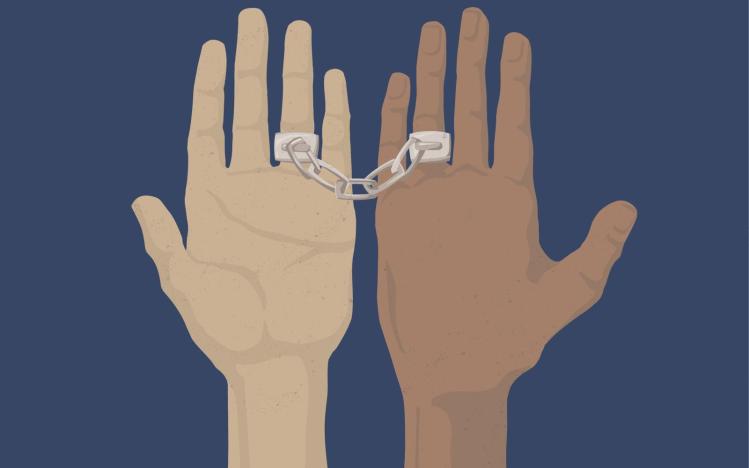
My divorce was final fifteen years ago. But the Catholic Church, to which I’m a recent convert, considers me still married.
My ex-husband (or am I still supposed to call him my husband?) and I exchanged vows in 1982 at the Madison Avenue Baptist Church in Manhattan. My grandfather, a Southern Baptist minister, presided. I was Baptist. My ex-husband was (then) a nonobservant Jew. We had two daughters. Motherhood changed my life, and I wanted to spend as much time with my children as I could during their short childhood. And so, after financing the down payment on our home, I left the practice of law and became a full-time stay-at-home mom.
A few years later, my ex-husband had an affair and served me with divorce papers at our front door. In front of our little girl, whom I was about to walk to school. I opposed the lawsuit. God help me, I loved him. I wanted to save my marriage and our beautiful family. At the time of the lawsuit, New York was the only state that hadn’t yet adopted no-fault divorce. That meant that unless I’d breached the marital contract—by committing domestic violence, adultery, cruelty, for example—he couldn’t divorce me against my will. For years, the Catholic Church in New York had successfully persuaded state legislators not to adopt no-fault divorce, my lawyer said. I was impressed. It was one of many reasons I would come to admire the Church.
But judges and lawyers who represented my ex-husband pressed me to give up my right to defend myself and my choice to remain married. If anybody had the right to sue, it was me; after all, he was the one having the affair. But I knew in my bones that I had to stand up and speak the truth. The stress of doing so nearly took me down. I even contemplated suicide. I didn’t dare tell anyone about this—not my friends, not my shrink, not my lawyer. My ex had threatened to seek sole custody of the children. By then, he was the one who earned the hefty paycheck, while I took care of the kids. So I lived in fear.
Several years after the lawsuit started, the third of seven judges dismissed all the charges against me. There would be no divorce, at least not then. I hoped my ex-husband’s girlfriend would finally disappear, but she didn’t. So he moved to New Jersey, which had adopted no-fault divorce, giving him the power to end our marriage. I had no choice but to give in. We settled custody, and a second trial ensued over property division. The new judge—a woman—pressured me to accept my ex-husband’s settlement demands and warned that my future hung in the balance. She shamed me for being a stay-at-home mom. She told me I needed a boyfriend. Although I’d once practiced law, nothing prepared me for the horrors of divorce court. The divorce was final in March 2009. My ex remarried a few days later.
I temped, became a landlord, and paid bills on ever-dwindling savings and child support. In 2010, New York adopted no-fault divorce as the other forty-nine states already had. Somehow the Church had lost its influence. I began writing about my experiences. I cofounded a volunteer bipartisan organization to advocate for divorce reform. Meanwhile, my children grew up. When I could no longer afford the mortgage, I sold my house, moved, and started over.
In December 2018, I converted to Catholicism. When a Catholic college friend heard the news, she texted to say I’d need an annulment to marry again. After years of heartache and hardship, I hoped a faithful midlife partner would come along. No one had. Still, my friend’s revelation stunned me. Surely, Church teachings about the permanency of marriage didn’t apply to me retroactively. My ex and I weren’t Catholic. I was a Baptist when I married my Jewish ex-husband, an Episcopalian when we divorced. We exchanged vows in a Protestant church. Catholicism came decades later.
My parish priest confirmed what my Catholic friend had told me. He handed me a twenty-five-page questionnaire to initiate the annulment process. It included questions about our marriage, divorce, and children. It asked specifics about our formative years, relationships with parents and siblings, and what we’d been taught about marriage, family, alcohol, and drugs. It sought details about our courtship, engagement, and wedding, down to the frequency of dates, nature of our disagreements, and sexual activity. Ironically, as the “petitioner” in an annulment case, this time I’d be the plaintiff. Annulment wouldn’t render my children illegitimate, the priest said. That made no sense to me. But okay. Despite prevailing myths, the cost of the annulment would be negligible. (My divorce lawyer had handed me a legal bill for six figures.) The “defect” required to invalidate our marriage must have existed at the time of the ceremony—four decades ago—thus preventing the necessary marital consent.
I began researching possible grounds. Had my ex-husband been intoxicated with alcohol during the ceremony? No. Impotent? No. Had he married not intending that the marriage exist forever? Not that I knew of. No homosexuality. No epilepsy. We weren’t blood relatives. Had my ex-husband suffered from an underlying psychological disorder preventing fulfillment of his marital promises? From impairments not initially obvious, like mental illness, addictions, or narcissistic and sociopathic personalities that became evident only during the marriage? If so, I’d need affidavits from corroborating witnesses. My family had never lived close by. They’d be no help, and I couldn’t envision most of them wanting to get involved in such a mess anyway. My parents would have rushed to my aid, but they were both dead. Most of my ex-husband’s family members were dead, too, and one lived abroad. Was I really expected to track down his old friends and pressure them to sign an affidavit against him?
The inquiry was becoming uncomfortable. My ex-husband would also be entitled to receive copies of all papers and could oppose the annulment. Having sued me for divorce and already remarried, maybe he couldn’t care less. But then again, we’d been through the War of the Roses. I was petrified that anything questioning his character—even for the sake of an annulment—might renew his wrath. For years, therapists and friends had warned me not to contact him. I’d ignored them early on, wanting to save my marriage. Finally, I’d listened, and it was only then that I was able to recover.
There was another problem. A declaration of nullity would mean that my marriage would be technically erased. How could that be? I had loved my husband and still loved the family we’d created. How could I accept the fact that the union I’d fought to preserve had never been a real marriage in the first place? Granted, I married in my twenties. Caught up in the whirlwind of a nine-month courtship, had I even known what “forever” meant? It’s hard to remember that far back, but I believe I did. At the time, there had never been a divorce in my family. I’d watched the ups and downs in the marriages of parents, grandparents, and aunts and uncles, and their reliance on God to see them through. They’d been my role models. If my ex-husband hadn’t left, we’d still be married in the eyes of the law and the Church. Annulment felt like getting off on some technicality. That felt wrong. It cheapened my marriage, even if the Church believed I was entitled to an annulment.
I spoke with my parish priest again. There was no rush, he said. I was headed for surgery that fall, so why not take some time to think it over, he suggested. “What about the Petrine privilege?” I asked. I’d stumbled across the reference during my research. Codified in the Church’s Canon Law 1150, it applies to marriages between Christians and non-Christians. “It’s called a petition in favor of the faith,” the priest said. A rarely used avenue, it takes longer than an annulment. That didn’t bother me. The petition must be presented in Rome to Pope Francis himself or someone acting on his behalf. Such petitions go back to the time of St. Peter, hence the name, and they have been granted by popes throughout history. The early Church believed that only two baptized persons could form a sacramental union. I was baptized; my husband wasn’t. Dissolving a marriage like ours had been seen as a way of preserving the faith of a new convert like me. It would also allow my marriage to remain recognized.
Instead of an annulment, I’d essentially receive a Catholic “divorce.” Having done what I could to preserve my marriage, I liked thinking that its dissolution would have been blessed by the early Church and could be administered by Peter’s own successor. I’m not a canon lawyer or scholar, but I’d also come across a reference to a statement made by Pope Pius XII to the Roman Rota in 1941 that seemed to support my view. He’d quoted Matthew 19:6: “What therefore God has joined together, let not man put asunder.” And then he added, “that is to say, not man but God can put asunder.” Didn’t the pope often act in persona Christi? Didn’t Christ tell his disciples, “Whatever you loose on earth will be loosed in heaven”? It seemed to me that if my union wouldn’t have been considered sacramental in the early Church, then its dissolution shouldn’t violate Catholic doctrine either. This was closure I could accept. I wanted to get started as soon as possible. My priest sent me an application.
I went home and opened my Catechism, eager to read more about marriage. The Catechism describes two aspects of marriage: the mutual and exclusive love and affection of spouses, and the transmission of life, through which marriage “finds its crowning glory.” I definitely considered my daughters “supreme gifts.” Perhaps my ex-husband and I got that part right.
I had always thought of marriage as sacred, but I began to view it in a deeper way. God had created marriage for my good, for the fulfillment of my highest potential. I’d never experienced this spiritual communion in which the Divine Creator was present, where spouses committed themselves “totally.” I can’t say I’d ever given myself totally to anyone like that. And what would it feel like to receive the exquisite gift of someone giving themselves completely and absolutely to me in the presence of the Holy Spirit? This biblical call to love one another was something else entirely, a “mystery,” as the Catechism put it, mirroring God’s own irrevocable love for me. This was mind-blowing. I wept. Perhaps I, too, would have another chance to experience this kind of marriage, but not unless the Church granted my petition.
But before I’d even finished filling out the petition, my parish priest phoned to say that the privilege wasn’t available to me after all—not until I, a woman the Church still considered married, got engaged first. It instantly reminded me of that last judge, the one who’d advised me to find myself a boyfriend. My ex-husband had betrayed our marriage and gotten engaged well before we divorced. I had to do what he’d done in order to apply for the Petrine privilege.
Why do Church rules seem to dovetail with the advice of family-court judges and the example of adulterers? Where is the fairness or mercy in that? And if the purpose of the Petrine privilege is to preserve my faith, why do the rules now seem to threaten it? As a convert, I struggle with these rules; they seem perverse, senseless, and cruel.
In 2022, my ex-husband and I would have celebrated our fortieth wedding anniversary. We’ve been apart now as long as we were together. Accepting the Church’s view that I’m still married feels like being forced to live a lie after years of mustering the courage to finally start over.
